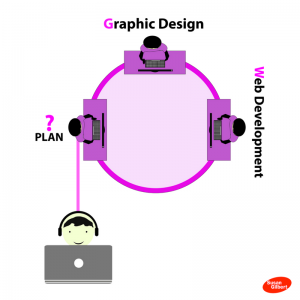After so many years spent assuming various leadership roles and analysing the life and habits of successful business leaders, I learnt one invaluable lesson that precedes all others:
A business will never be successful unless you learn how to build positive relationships and put people first.
The other day, I came across a shocking statistic that caused me to contemplate this particular lesson. A Gallup poll reports that almost 70% of employees claim that do not feel actively engaged in their jobs. If you consider this shocking loss of productivity in terms of financial loss, it costs the American economy alone a whopping $ 350 billion every single year.
Clearly a business is doomed to fail if it constitutes a disconnected workforce. Coming back to the topic at hand, this is precisely why your style of leadership can be the make or break factor when it comes to properly engaging your workforce.
My personal approach to human leadership has always been underscored by the principle that even in the world of business, who you are matters. I believe that men and women who lead from the inside out have the greatest impact on their business, and the personal and professional lives of those who follow them.
How does one do that? By leading with the heart over the head sometimes.
What does leading with the heart look like? I’ll explain it in a series of quick bullet points:
– You embrace and exhibit positive characteristics such as empathy, respect, cooperation, gratitude, and compassion.
– You respond to your intuition and attune your mind to your instincts.
– You openly respond to your primary human urge to give, share, and inspire.
– You focus on giving and relinquish your fears.
– You let go of worry, because you understand that you don’t need anything.
– You are happy and satisfied by the actions you take, regardless of the outcome.
I understand that I will be able to explain my point better by creating a comparison of leading from the heart to leading from the mind.
To lead from the mind means:
– You work only according to your goals, expectations, and plans.
– You put precedence on the practical need to get things done.
– You constantly fear rejection and disappointment because you are paranoid.
– You constantly worry about what people will think of your actions.
– Your happiness depends only on whether or not your expectations are met.
I am of the firm belief that the first and foremost hallmark of a good leader is their ability to make their employees feel special. Heart leaders are generous when it comes to giving due recognition to the contributions that each team member brings to the company, because heart leaders take the time to get to know their employees on a personal front.
For heart leaders, connecting to their employees’ feelings is what empowers them to provide the tools and support necessary to rally their team around their vision and motivate them to perform as their best possible selves.
So how does one begin leading from the heart?
Remember that the ultimate aim of heart leadership is to connect with your followers’ feelings and bridge the gap between you, in order to produce higher yield. Remember that an effective workforce will emerge from within your existing team, only if you are willing to compromise and meet your staff where they currently stand.
The first step towards becoming a heart leader is to become more empathetic. Begin by starting to see your business and your leadership from your employees’ perspective.
In order to develop empathy, it is critical that you learn to understand, respect, and embrace others’ points of view instead of forcing your own perspective on them every time.
Fair warning: this can be a frustrating exercise, considering that it is probable that your workers’ perspectives are counterintuitive to the way you choose to govern them.
But ultimately, it will be worth it because embracing heart leadership will lead to the development of a thriving culture that implements your own core values and goals.
Heart leaders are genuinely concerned for the careers and lives of their team members. They actively listen to what their employees have to say and consider them people, not numbers on a sheet. The respect and dignity that heart leaders choose to give their workers fosters a considerate and compassionate environment where both the minds and the hearts of their employees are fully engaged.
In order to further illustrate my point about heart leadership, I will ask you to envision the other end of the line.
Remember your own tenure as an employee following leaders throughout your career journey.
How often did you feel like you don’t like or trust the person you are working for?
Did you always feel safe enough to take risks or think outside the box?
Did you feel that the organizational environment was toxic for yourself or for others?
On the other hand, let’s remember the positives you experienced in this time too:
Did you ever work for a leader who remembered your name, and asked about your personal life with genuine interest?
Did you ever work for a boss who made you feel valued and worthy by acknowledging and appreciating your contributions to the team?
Did you ever work for a leader whose care and support empowered you to take risks and do more in your position?
I will leave you with a few final thoughts. Of course, embracing heart leadership does not entail running a business with warm fuzzy feelings and without any substance. Heart leadership is about connecting with the hearts of your people and taking actions to lead the team forward, not just the organization.
Heart leadership is a psychology for leadership success based on the tried and tested habits of successful people.
This style of leadership is best implemented when combined with using the mind to ensure that all the practical aspects of leadership are intact.
Heart leadership in coalescence with mindful leadership improves the conditions of the workplace, thereby leading to:
– Higher profits
– Increased sales
– Reduced turnovers
– And most importantly, strong and reinforced teams.
Remember that your style of leadership depends on the conscious and subconscious rules you apply to the workplace. What you give to your team, and how you practice decision-making, are critical aspects of leadership as well. Notice the distinctions between your different points of view and observe which strategies you currently tend to use.
Always be open to trying a variety of different strategies to see how you feel about them and what kind of outcomes are generated in your workplace.
So, is it better to lead with your heart or your head? Is it important to use either or?
Imagine what would happen if your heart and mind agree.
Business & Finance Articles on Business 2 Community
(95)
Report Post




